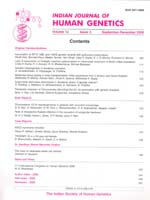
|
Indian Journal of Human Genetics
Medknow Publications on behalf of Indian Society of Human Genetics
ISSN: 0971-6866
EISSN: 0971-6866
Vol. 17, No. 3, 2011, pp. 169-174
|
 Bioline Code: hg11037
Bioline Code: hg11037
Full paper language: English
Document type: Research Article
Document available free of charge
|
|
|
Indian Journal of Human Genetics, Vol. 17, No. 3, 2011, pp. 169-174
| en |
Haptoglobin polymorphism among the tribal groups of southern Gujarat
Khurana, Priyanka; Aggarwal, Aastha; Huidrom, Suraj Singh. & Kshatriya, Gautam K.
Abstract
Background : Gujarat is located at the western most point of the Indian subcontinent. Valsad and Surat districts are part of the ′tribal belt′ of Gujarat and constitute 29.1% of total tribal population of Gujarat. These tribal populations are a rich source of gaining insights in the patterns of genetic diversity and genetico-environmental disorders against the back drop of their ecological, historical and ethnographic aspects.
Aim : The objectives were to find out a) the genetic diversity among the tribes of Gujarat with reference to haptoglobin (Hp) locus b) the relationship between Hp polymorphism and sickle cell anemia/trait.
Materials and Methods: 431 individuals belonging to eight tribal groups were studied for Hp polymorphism using polyacrylamide disc gel electrophoresis (PAGE). HbFNx01S was screened by dithionate tube turbididy (DTT) test and confirmed using cellulose acetate membrane electrophoresis (CAME).
Statistical Analysis: Allele frequency was calculated by direct gene counting method. Average heterozygosity and gene diversity were computed using software DISPAN. Analysis of molecular variance (AMOVA) was estimated using software ARLEQUIN version 3.1.
Results and Conclusions: Pattern of allele frequency distribution showed preponderance of Hp 2 allele in all the eight tribal groups, which is in accordance with its frequency in different populations of Indian subcontinent. Total average heterozygosity (H T ) was found to be low (0.160) but the level of genetic differentiation (G ST ) was found to be moderately high (5.6%). AMOVA analysis indicated least among group variance between west and south Indian populations (-0.04%) indicating the affinities of the tribes of Gujarat with that of Dravidian speaking groups. Analysis of Hp phenotypes among sickle cell anemia/ trait individuals revealed a high frequency of Hp 0-0 phenotype (92.7%) among SS individuals as opposed to only 9.7% among AS individuals, reaffirming the selective advantage of HbAS state in relation to hemolytic disorders.
Keywords
AMOVA , haptoglobin, heterozygosity, hypohaptoglobinaemia, sickle cell anemia, tribes.
|
| |
© Copyright 2011 Indian Journal of Human Genetics.
Alternative site location: http://www.ijhg.com/
|
|
